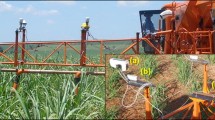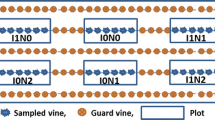Abstract
Recent advances in optical designs and electronic circuits have allowed the transition from passive to active proximal sensors. Instead of relying on the reflectance of natural sunlight, the active sensors measure the reflectance of modulated light from the crop and so they can operate under all lighting conditions. This study compared the potential of active and passive canopy sensors for predicting biomass production in 25–32 randomly selected positions of a Merlot vineyard. Both sensors provided estimates of the normalized difference vegetation index (NDVI) from a nadir view of the canopy at veraison that were good predictors of pruning weight. Although the red NDVI of the passive sensors explained more of the variation in biomass (R 2 = 0.82), its relationship to pruning weight was nonlinear and was best described by a quadratic regression (NDVI = 0.55 + 0.50 wt−0.21 wt2). The theoretically greater linearity of the amber NDVI-biomass relationship could not be verified under conditions of high biomass. The linear correlation to stable isotope content in leaves (13C and 15N) provided evidence that canopy reflectance detected plant stresses as a result of water shortage and limited fertilizer N uptake. Thus, the canopy reflectance data provided by these mobile sensors can be used to improve site-specific management practices of vineyards.




Similar content being viewed by others

References
Bausch, W. C., & Delgado, J. A. (2003). Ground-based sensing of plant nitrogen status in irrigated corn to improve nitrogen management. In T. VanToai et al. (Eds.), Digital imaging and spectral techniques: Applications to precision agriculture and crop physiology (pp. 145–157). ASA Special Publication 66. Madison, WI: ASA, CSSA, SSSA.
Bort, J., Araus, J. L., Hazzam, H., Grando, S., & Ceccarelli, S. (1998). Relationships between early vigour, grain yield, leaf structure and stable isotope composition in field grown barley. Plant Physiology and Biochemistry, 36, 889–897.
Dobrowski, S. Z., Ustin, S. L., & Wolpert, J. A. (2003). Grapevine dormant pruning weight prediction using remotely sensed data. Australian Journal of Grape and Wine Research, 9, 177–182.
Farquhar, G. D., Ehleringer, J. R., & Hubick, K. T. (1989). Carbon isotope discrimination and photosynthesis. Annual Review of Plant Physiology and Plant Molecular Biology, 40, 503–537.
Gitelson, A. A., Kaufman, Y. J., Stark, R., & Rundquist, D. C. (2002). Novel algorithms for remote estimation of vegetation fraction. Remote Sensing of Environment, 80, 76–87.
Gitelson, A., & Merzlyak, M. N. (1996). Signature analysis of leaf reflectance spectra: Algorithm development for remote sensing of chlorophyll. Journal of Plant Physiology, 148, 494–500.
Gitelson, A. A., Vina, A., Arkebauer, T. J., Rundquist, D. C., Keydan, G. P., & Leavitt, B. (2003). Remote estimation of leaf area index and green leaf biomass in maize canopies. Geophysical Research Letters, 30, 1248.
Hall, A., Louis, J. P., & Lamb, D. W. (2008). Low-resolution remotely sensed images of winegrape vineyards map spatial variability in planimetric canopy area instead of leaf area index. Australian Journal of Grape and Wine Research, 14, 9–17.
Holland, K. H., Schepers, J. S., & Shanahan, J. F. (2006). Configurable multi-spectral active sensor for high-speed plant canopy assessment. In D. J. Mulla (Ed.), Proceedings of the 8th international conference on precision agriculture (CD). Minneapolis, MN: University of Minnesota.
Institute, S. A. S. (1990). SAS/STAT User’s guide, version 6 (4th ed.). Cary, NC, USA: SAS Institute Inc.
Johnson, L. F. (2003). Temporal stability of an NDVI-LAI relationship in a Napa Valley vineyard. Australian Journal of Grape and Wine Research, 9, 96–101.
Johnson, L. F., Roczen, D. E., Youkhana, S. K., Nemani, R. R., & Bosch, D. F. (2003). Mapping vineyard leaf area with multispectral satellite imagery. Computers and Electronics in Agriculture, 38, 33–44.
Lamb, D. W. (2004). Remote sensing technologies for the grape and wine industry. In S. Stamatiadis & J. S. Schepers (Eds.), Remote sensing for agriculture and the environment (pp. 226–236). Larissa, Greece: Peripheral Publications “ella”.
O’Leary, M. H. (1993). Biochemical basis of carbon isotope fractionation. In J. R. Ehleringer, A. E. Hall, & J. D. Farquhar (Eds.), Stable isotopes and plant carbon–water relations (pp. 19–26). San Diego: Academic Press.
Schepers, J. S., Blackmer, T. M., Wilhelm, W. W., & Resende, M. (1996). Transmittance and reflectance measurements of corn leaves from plants with different nitrogen and water supply. Journal of Plant Physiology, 148, 523–529.
Schepers, J. S., Francis, D. D., & Thompson, M. T. (1989). Simultaneous determination of total C, total N, and 15N on soil and plant material. Communications in Soil Science and Plant Analysis, 20, 949–959.
Shearer, G. B., & Legg, J. O. (1975). Variations in the natural abundance of 15N of wheat plants in relation to fertilizer nitrogen applications. Soil Science Society of America, Proceedings, 39, 896–901.
Stamatiadis, S., Christofides, C., Tsantila, E., Taskos, D., Tsadilas, C., & Schepers, J. S. (2007). Relationship of leaf stable isotopes (δ13C and δ15N) to biomass production in two fertilized Merlot vineyards. American Journal of Enology and Viticulture, 58, 67–74.
Stamatiadis, S., Taskos, D., Tsadilas, C., Christofides, C., Tsadila, E., & Schepers, J. S. (2006). Relation of ground-sensor canopy reflectance to biomass production and grape color in two Merlot vineyards. American Journal of Enology and Viticulture, 5, 415–422.
Acknowledgments
This project was carried out jointly by USDA-ARS and the Gaia Environmental Research and Education Center of the Goulandris Natural History Museum (Specific Cooperative Agreement # 58-4012-0-F169) together with the Institute of Soil Mapping and Classification of the National Agricultural Research Foundation.
Author information
Authors and Affiliations
Corresponding author
Rights and permissions
About this article
Cite this article
Stamatiadis, S., Taskos, D., Tsadila, E. et al. Comparison of passive and active canopy sensors for the estimation of vine biomass production. Precision Agric 11, 306–315 (2010). https://doi.org/10.1007/s11119-009-9131-3
Received:
Accepted:
Published:
Issue Date:
DOI: https://doi.org/10.1007/s11119-009-9131-3



